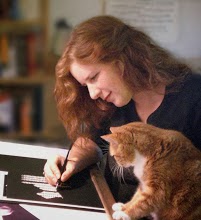But sometimes a gal just needs color.
Now there are two ways to do color with scratchboard - one is to start with the standard black scratchboard as you've seen in previous posts, and to apply washes of color (generally with ink, acrylic, or other media). To prepare for this one must 'overscratch' the board, basically scratching off a bit more of the black than you would if it were going to remain black and white. After the colour washes you scratch more, and continue alternating until you get the effect you're going for. Ending up with something like this:

'Mother's Arms' 9x12 Ampersand Scratchboard (c) Pam Boutilier 2009
The other way is to use whiteboards. A whiteboard (WB) is the same as a standard scratchboard (SB) but does not have the india ink layer on the top - it's just white clay and very smooth. Before scratching you must apply your surface medium and this allows you to play with colour! Many media can be used - ink, paint, coloured pencil... the effect is slightly different for each.
If you want to see some amazing scratchboard and some very good instructive information please check out Diana Lee's website: www.dianalee.com or better yet check out some of her posts on www.WetCanvas.com (which is where I'm learning all of this from)!
Following is my first attempt at a whiteboard - this is done on a 6x6" WB using inks in the form of Inktense Pencils (by Derwent) and Liquid ink (Ampersand). I really like the deep, vibrant colour achieved with inks - though the colour range isn't as dynamic as you can achieve with coloured pencil. My biggest frustration with the Inktense pencils is that, because they are water soluble, the ink is never fully permanent - so it is difficult to go back and do new layers without mobilizing some of the earlier ink and blunting your scratching efforts.

'Emma' 6x6 Ampersand Claybord (c) Pam Boutilier 2009
After my practice piece I was ready to jump in so next I tacked a 9x12" WB - only this time I chose a reference photo that I thought I could work with. The Emma photo was not really detailed enough for scratchboard, but was perfect for practice. For board #2 I chose this old photo of my girl, Rosie:

As always it starts with a sketch;

I decided to crop it close and change the position of her eye a little to better reflect her personality. Rosie was my dog - an English Bulldog rescue. We had 10 years together before she passed away in 2006 from complication of lymphoma. That's a pretty good age for a bulldog - and she got to boss lots of folks around in her ten years!

Next is applying the ink - after my experience with the pencils I decided to go with all liquid ink (Ampersand ink). Thanks to a wonderful oil painting class I took a couple of years back I feel pretty comfortable with colour mixing - which is good when you only have yellow, blue, green, magenta, black and sepia to work with!

At this stage it reminds me of pop-art.. but remember, the ink will be scratched through so this base layer has to be very deep and dark if you want real depth in the final image - it seems I actually learned quite a bit from that little practice piece above!
Next time I'll post some further stages and the finished product.
~ Pam





2 comments:
Great work! I have also played with scratch board and really liked
it. Have you used Prisma colored pencils on it? I have only used inda ink so far.
Konazagraphics, thanks!! I have played a bit with CP, and you can get a much wider colour range with them. But I'm in love with the vibrancy and contrast I can get with the inks. If you want to see some amazing whiteboards using prismacolors check out some of Diana's work on Wetcanvas.com!
Post a Comment